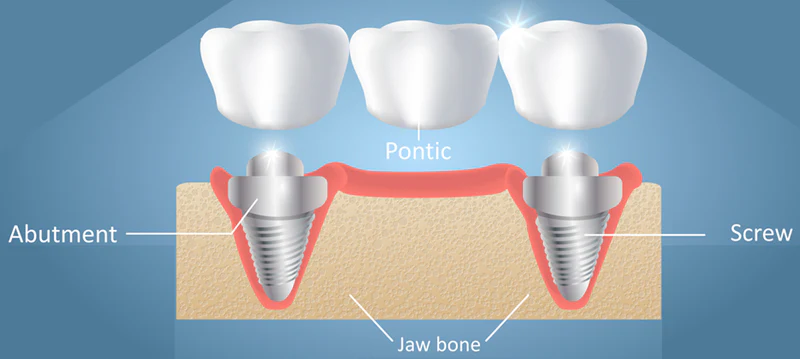When it comes to implant-supported restorations, one decision can impact everything — from tissue health to marginal fit to esthetic outcomes.
That decision?
Choosing the correct abutment height.
Whether you’re restoring a single crown, a bridge, or a full-arch prosthesis, the height of your abutment — particularly the collar height or gingival height — plays a crucial role in how the final restoration looks, functions, and lasts.
In our lab, we’ve worked with everything from original manufacturer abutments to generic imports. But for the past two years, we’ve relied on OEMDent’s titanium bases and custom abutments — because they offer a full range of collar heights, clean emergence profiles, and predictable soft tissue behavior.
If you’ve ever been unsure which abutment height to pick — or why it even matters — this guide is for you.
🦷 What Is Abutment Height?
In simple terms, abutment height (or collar height) refers to the vertical portion of the abutment that extends above the implant platform and sits under the restoration — but within the soft tissue.
It’s what shapes the emergence profile and determines where the crown margin ends. Get it wrong, and you could end up with:
- Overexposed metal collar
- Subgingival cement overflow
- Soft tissue irritation or inflammation
- Frustrated dentists or remake requests
📏 Common Abutment Heights — and What They’re For
OEMDent offers multiple collar heights for both straight and angled titanium bases, typically ranging from:
- 0.5mm
- 1.0mm
- 2.0mm
- 3.5mm
So, how do you know which one to choose?
✅ 0.5mm – For Shallow Tissue Depths
Best for:
- Anterior esthetic zones
- Thin biotypes
- Bone-level implant placements with minimal tissue coverage
Why it works:
A low collar ensures the crown margin stays just at or slightly subgingival, which is ideal for cementable cases where cleanup is critical and visibility matters.
✅ 1.0–2.0mm – The “Standard” Zone
Best for:
- Most posterior restorations
- Average tissue depth (1.5–3mm)
- Situations where a screw-retained crown is planned
Why it works:
This range supports healthy soft tissue emergence without exposing metal or burying margins too deep. It allows for ideal transition from implant to restoration, especially in molars or premolars.
This is the most commonly used range in our lab — especially when using OEMDent’s titanium bases for MIS®, Zimmer®, or Straumann® platforms.
✅ 3.5mm – For Deep Subgingival Implants
Best for:
- Implants placed subcrestally
- Thick biotypes
- Tissue depths over 3mm
- Full-arch bar designs or deep screw channels
Why it works:
These are lifesavers when an implant is buried deeper than expected or when soft tissue is particularly thick. A longer collar avoids “choking” the tissue and brings the margin closer to where you can actually reach it for cleaning, cement, or finishing.
💡 Pro Tips from the Lab
We’ve worked on thousands of implant cases over the years. Here’s what we’ve learned:
- Never Guess the Tissue Depth
Use a periodontal probe or tissue measuring tool during the impression or scan phase to determine exactly how deep the implant is. Even a 1mm miscalculation can make a world of difference.
- When in Doubt, Go Taller
You can always trim a longer collar. You can’t grow a shorter one. Taller collars help reduce deep cement lines, which means cleaner deliveries and happier peri-implant tissue.
- Match the Abutment to the Restoration Type
- Cement-retained? You want a collar that brings the margin to the gingival level — not too high, not too low.
- Screw-retained? You’re less worried about cement and more about emergence and screw access angle.
- Account for Bone Resorption and Future Remodeling
If you’re working on immediate placements or know there’s going to be some tissue remodeling, plan for change. Choosing a taller abutment now might prevent problems later.
- Take Advantage of OEMDent’s Part Variety
One reason we switched to OEMDent is because they offer:
- Multiple heights per platform
- Straight and angled bases
- Indexed and non-indexed options
- Clear part labeling for fast reordering
That means we’re never stuck using “whatever’s available.” We use exactly what the case needs.
➡️ Shop All OEMDent Abutments by Compatibility
🧪 Case Study: The Trouble with a 0.5mm Abutment
One of our dentists placed a molar implant and requested a 0.5mm titanium base — assuming a shallow tissue depth. But when the crown came back, the margin was almost 2mm subgingival, and cement cleanup was nearly impossible.
We remade the case with a 2.0mm OEMDent base, which brought the margin just to tissue level. The dentist reported easier delivery, no bleeding, and a happy patient.
Lesson: always measure, and don’t undercut the collar height to save time.
💬 Final Thoughts: Height = Health + Harmony
Choosing the right abutment height isn’t just a technical checkbox — it’s the key to long-term tissue health, esthetic success, and predictable lab workflows.
With OEMDent’s range of collar heights and compatible platforms, you’re not stuck making compromises. You’re equipped to make smart, case-specific choices that deliver real results.
Stop guessing. Start planning smarter.
👉 Browse OEMDent’s Full Line of Abutments and Titanium Bases


